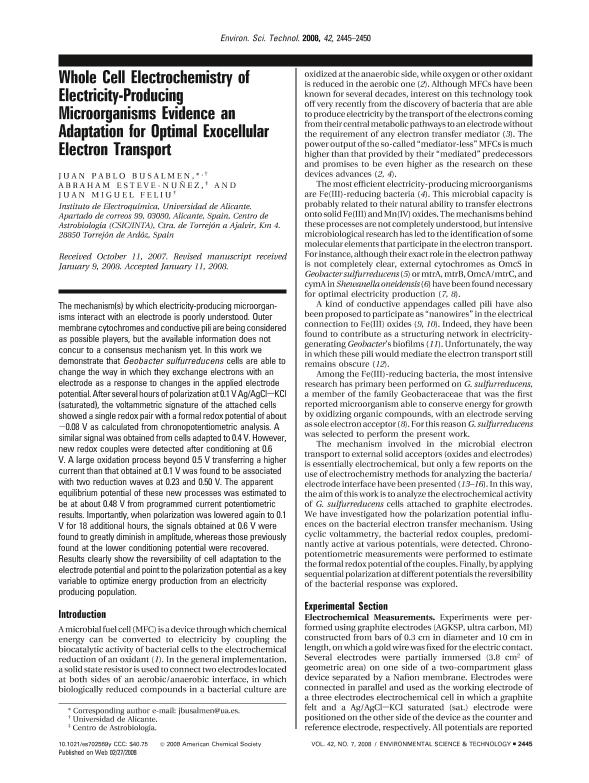Mostrar el registro sencillo del ítem
dc.contributor.author
Busalmen, Juan Pablo

dc.contributor.author
Esteve Núñez, Abraham

dc.contributor.author
Miguel Feliu, Juan
dc.date.available
2019-01-14T14:18:11Z
dc.date.issued
2008-04
dc.identifier.citation
Busalmen, Juan Pablo; Esteve Núñez, Abraham; Miguel Feliu, Juan; Whole cell electrochemistry of electricity-producing microorganisms evidence an adaptation for optimal exocellular electron transport; American Chemical Society; Environmental Science & Technology; 42; 7; 4-2008; 2445-2450
dc.identifier.issn
0013-936X
dc.identifier.uri
http://hdl.handle.net/11336/67967
dc.description.abstract
The mechanism(s) by which electricity-producing microorganisms interact with an electrode is poorly understood. Outer membrane cytochromes and conductive pili are being considered as possible players, but the available information does not concur to a consensus mechanism yet. In this work we demonstrate that Geobacter sulfurreducens cells are able to change the way in which they exchange electrons with an electrode as a response to changes in the applied electrode potential. After several hours of polarization at 0.1 VAg/AgCl-KCl (saturated), the voltammetric signature of the attached cells showed a single redox pair with a formal redox potential of about -0.08 V as calculated from chronopotentiometric analysis. A similar signal was obtained from cells adapted to 0.4 V. However, new redox couples were detected after conditioning at 0.6 V. A large oxidation process beyond 0.5 V transferring a higher current than that obtained at 0.1 V was found to be associated with two reduction waves at 0.23 and 0.50 V. The apparent equilibrium potential of these new processes was estimated to be at about 0.48 V from programmed current potentiometric results. Importantly, when polarization was lowered again to 0.1 V for 18 additional hours, the signals obtained at 0.6 V were found to greatly diminish in amplitude, whereas those previously found at the lower conditioning potential were recovered. Results clearly show the reversibility of cell adaptation to the electrode potential and point to the polarization potential as a key variable to optimize energy production from an electricity producing population.
dc.format
application/pdf
dc.language.iso
eng
dc.publisher
American Chemical Society

dc.rights
info:eu-repo/semantics/openAccess
dc.rights.uri
https://creativecommons.org/licenses/by-nc-sa/2.5/ar/
dc.subject
Electrode-Reducing Bacteria
dc.subject
Bioenergy
dc.subject
Bioelectrochemistry
dc.subject.classification
Otras Ciencias Químicas

dc.subject.classification
Ciencias Químicas

dc.subject.classification
CIENCIAS NATURALES Y EXACTAS

dc.title
Whole cell electrochemistry of electricity-producing microorganisms evidence an adaptation for optimal exocellular electron transport
dc.type
info:eu-repo/semantics/article
dc.type
info:ar-repo/semantics/artículo
dc.type
info:eu-repo/semantics/publishedVersion
dc.date.updated
2019-01-09T14:23:58Z
dc.journal.volume
42
dc.journal.number
7
dc.journal.pagination
2445-2450
dc.journal.pais
Estados Unidos

dc.description.fil
Fil: Busalmen, Juan Pablo. Consejo Nacional de Investigaciones Científicas y Técnicas. Centro Científico Tecnológico Conicet - Mar del Plata. Instituto de Investigaciones en Ciencia y Tecnología de Materiales. Universidad Nacional de Mar del Plata. Facultad de Ingeniería. Instituto de Investigaciones en Ciencia y Tecnología de Materiales; Argentina
dc.description.fil
Fil: Esteve Núñez, Abraham. Universidad de Alicante; España
dc.description.fil
Fil: Miguel Feliu, Juan. Universidad de Alicante; España
dc.journal.title
Environmental Science & Technology

dc.relation.alternativeid
info:eu-repo/semantics/altIdentifier/url/https://pubs.acs.org/doi/abs/10.1021/es702569y
dc.relation.alternativeid
info:eu-repo/semantics/altIdentifier/doi/http://dx.doi.org/10.1021/es702569y
Archivos asociados
